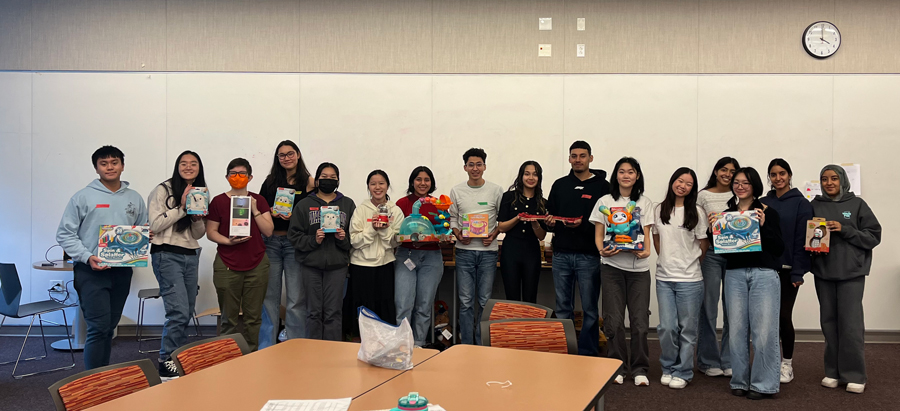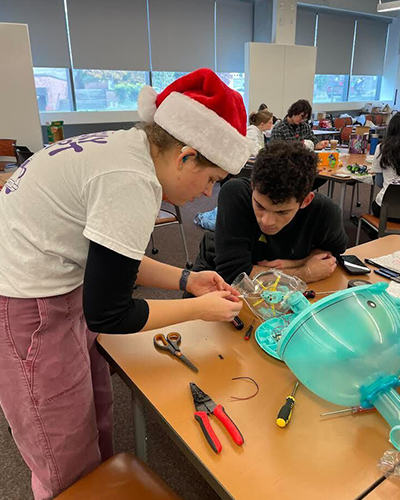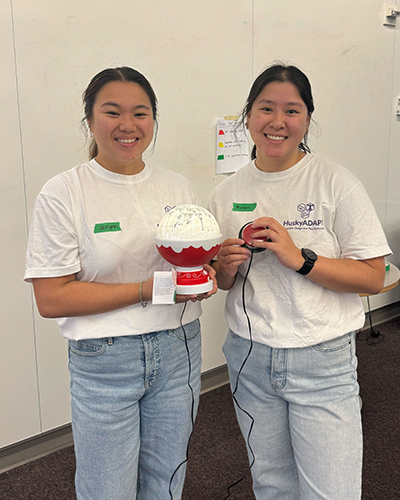By Lyra Fontaine

Students at HuskyADAPT's holiday toy adaptation event. Photo courtesy of HuskyADAPT.
Holiday music filled the air at a November toy adaptation event funded by AccessComputing and hosted by HuskyADAPT, a UW student organization dedicated to supporting accessible design and inclusive play technology. About 80 volunteers adapted toys, ranging from a baseball pitching machine and spinning art kit to lava lamps, remote control cars and a bilingual play drum.

At a recent event, students learned how to adapt toys to make them accessible for local children with disabilities. Photo courtesy of HuskyADAPT.
The volunteers connected the toys to a switch that can make it easier for children with disabilities to interact with the object in a way that’s accessible to them, such as pressing a button, moving their head or blowing air. For example, a child with spinal muscular atrophy, a genetic disease that impacts muscle strength, could activate an adapted toy by moving a finger or tilting their head instead of pressing a small button on the toy.
All the 36 toys successfully adapted during the event went to the holiday party of nonprofit Emma's Exceptional Equipment Exchange, where families were able to select switch-accessible toys for their children to receive this holiday season. HuskyADAPT members say that toy adaptation events play an important role in providing accessible toys to families, fostering an inclusive environment and equipping students with engineering skills.
“Every kid deserves to play, and play is an important part of a child’s development, but many commercial toys aren’t accessible right away,” says Ph.D. student Mia Hoffman, who leads HuskyADAPT. “We work to adapt toys to a switch that a child is already comfortable using, such as turning on lights at home. For younger kids, switch-adaptive toys are key to learning concepts such as cause and effect.”
Since commercial switches can be expensive, HuskyADAPT has been developing their own low-cost switches that can be made by anyone for less than $5.

Jaelynn Hunt-Osburn and Maelynn Danke, who lead HuskyADAPT's toy adaptation workshops, holding a switch-adapted toy. Photo courtesy of HuskyADAPT.
Seniors Jaelynn Hunt-Osburn and Maelynn Danke lead HuskyADAPT’s toy adaptation workshops at the UW and across the greater Seattle area that are open to both students and community members, including parents, educators and physical therapists. Working across campus and with organizations such as Microsoft and the King County Library System, they teach participants across all skill levels the entire process of adapting toys, including disassembly, soldering, basic circuit analysis and how to troubleshoot broken toys.
The process includes seeing how the toy functions, disassembling the toy and using a test wire to see where to solder the wire that will connect it to the adaptive switch. After drilling holes, the toy adapter will solder the wire to the toy, connect it to the switch and test it.
Hunt-Osburn and Danke, who are studying electrical and computer engineering, say it’s rewarding to watch people who may not know about switch-adapted toys leave workshops with the ability to make a toy switch-accessible.
“The principles applied in accessible design, as demonstrated in our workshops and across our club, are valuable for anyone pursuing a career in engineering,” says Hunt-Osburn.
“These types of designs don't have to be complicated, but they can play a crucial role in fostering inclusive environments where individuals, regardless of ability, can learn and grow,” Danke adds.
How to get involved in HuskyADAPT
If you’re interested in supporting HuskyADAPT’s mission, you can get involved in events or donate. Switch-adapted toys can be requested and are provided for free. HuskyADAPT is also accepting donations to their holiday wish list.
Originally published December 12, 2024